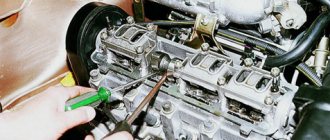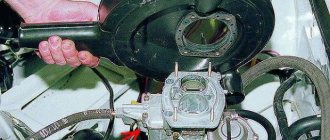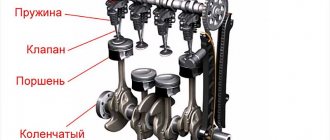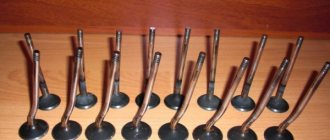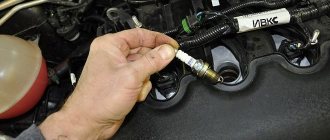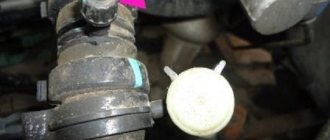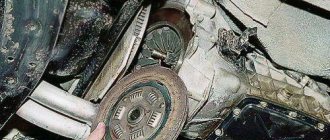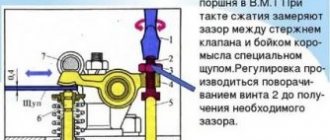Checking and adjusting valve clearances on Niva 2121
During engine operation, natural wear and tear occurs on its rubbing and contacting parts, including valves, rockers, and camshafts.
The gap in the “camshaft cam-rocker valve” drive increases, a knocking noise appears. They call it “valve knock”. It is clearly distinguishable against the background of other noises, is heard at regular intervals, and its frequency is less than the frequency of any other knock in the engine. Sometimes this valve knocking noise disappears completely after the engine warms up. If you have this clicking noise, it’s time to think about adjusting the thermal gap (later adjusting the valves) between the rocker and the camshaft cam. It is better to time the valve adjustments to coincide with changing the engine oil.
Why? Dust, dirt, sand that accidentally gets into the engine during adjustment will be removed along with the old oil and oil filter.
Thermal clearances are checked and adjusted on a cold engine.
For intake valves (2, 3, 6, 7) the gap is set to 0.15 mm, and for exhaust valves (1, 4, 5, – 0.2 mm.
It is not at all necessary to memorize which intake and which exhaust valves, just look at the intake and exhaust manifolds. The intake valves will be located opposite the intake manifold pipes, and the exhaust valves will be located opposite the exhaust manifold pipes.
Try to set the gap as accurately as possible. With a large gap, severe wear of the rocker, camshaft cam and valve end occurs, and with a small gap, the valve plates burn out.
Before adjusting the valves, you must first check the fastening of the camshaft bearing housing, the alignment of the marks on the crankshaft pulley and the camshaft sprocket, and tighten the chain.
You can adjust it in two ways, using probes or using a special device with a micrometer. Adjusting with feeler gauges is a long and imprecise operation. Uneven surfaces between the rocker and the camshaft cam are not taken into account; accordingly, the gap will be plus or minus a kilometer. Therefore, it is better to give preference to a bar with a micrometer. All eight valves can be adjusted easily, accurately and quickly within 18-22 minutes. It is impossible to make a mistake in the adjustment order, since the valve number is indicated on the bar and at what angle the crankshaft must be turned to adjust it. Even a beginner can easily handle the procedure.
- Signs of valve failure on Niva 2121
- What should be the gaps between the valves on Niva 2121
- Video: VAZ 2121 NIVA Valve adjustment
- How to adjust valve clearances on a Niva 2121 with your own hands - step-by-step instructions
- Common mistakes when adjusting valves on Niva 2121
- Video: How to adjust valves on a Niva 2121 with your own hands
Installation
After removing the hydraulics, carefully remove any remaining oil and coke from the wells. Degrease the internal threads with something decent (gasoline, acetone, white spirit). Mount the screws into the cylinder head (tightening torque is about 7-8 kg). We kindly request. Technologies do not stand still. Use a medium-strength thread locker for this operation. The price list includes a product that I use during assembly, manufactured by Febi (Germany). There is nothing more disgusting than the moment when you start the operation - “adjusting the field valves”, and suddenly you see that the screw is rotating along with the lock nut. I'll tell you a secret, everything will have to be disassembled and reassembled)). After this operation, I recommend taking a short break; there will be enough time for lunch for the thread locker to polymerize. After this you can install everything else. Don't forget a few drops of motor oil or mounting paste on the working surface of the rocker and the soldier's ball.
Why do you need to make adjustments?
Adjustment of Niva valves is required for the power plant to operate normally. Our task is to maintain the gap between the valves set by the manufacturer. If the distance between the parts exceeds the permissible norm, the driver hears unpleasant noises made by the car engine. When the valves are too tight, the power plant cannot produce maximum power, dynamics suffer and fuel consumption increases. You can find out how often this procedure needs to be carried out in the car’s operating manual; the procedure is also indicated there.
As the experience of owners of domestic models of this brand shows, correct valve adjustment is enough for 20 thousand kilometers. Determining that the gaps need adjustment is quite simple: grinding, clattering and other noises appear, which become especially loud at medium and low speeds.
It is important to know that the procedure is performed on a completely cold engine. The approximate temperature should not exceed +25 degrees Celsius. For work you will need open-end wrenches No. 17 and No. 13, a probe with a diameter of 0.15 mm. Probes should be chosen that are new or not worn out. Otherwise, the gaps will actually be smaller than necessary. Setting sequence:
- Unscrew the spark plugs and disconnect the battery.
- Remove the valve cover from the engine.
- Align the camshaft and crankshaft according to the marks at the dead center of the 4th cylinder. (Rotate with the key by the ratchet or by hand).
- Align the camshaft so that the sprocket mark coincides with the protrusion on the housing.
- Next, adjust valves 6 and 8 (counting from left to right). A 0.15 mm feeler gauge should be inserted between the rocker and the camshaft cam. It should go in with little effort.
- If the gap does not match, loosen the lock nut and use wrench No. 13 to adjust the gap (when fixing the lock nut, the set distance may decrease, so check it again with a feeler gauge).
- Next, rotate the crankshaft 180 degrees and adjust the clearances in valves 1 and 3. The adjustment principle is the same.
- Rotate the crankshaft 540 degrees and adjust 2 and 5 valves.
To make it easier to control the rotation of the crankshaft, it is recommended to put a mark on it. You can also mark the speed using the distributor slider. In this case, each pair of valves is adjusted through each 90-degree turn. In modern car services, they use a special indicator instead of a dipstick.
Question answer
How often are the Niva valves adjusted? I recommend carrying out the second adjustment, which I call final, after 500-700 km, after installing the kit and the first adjustment. As a rule, 2-3 valves “run away”. According to Soviet books and training manuals, it was recommended to CHECK the gaps once every 12-20 thousand km, that is, about once a year. Operational practice has shown that engines run without adjustment for 50 and 80 thousand km. Therefore, the following recommendation is factual.
A series of articles devoted to hydraulic compensators and bolts:
Part 4. Installing the “death to hydraulics” kit and adjusting the gaps
Quite often, VAZ 2123 owners refuse to change the hydraulic thermal gap compensators when they fail, preferring to install the adjusting bolts used in all lines of the classic VAZ family. This approach requires manual adjustment of the Chevrolet Niva valves. This type of adjustment has two significant drawbacks:
- The need to carry out work every 15 thousand km;
- Having a certain skill.
Step-by-step instructions for adjusting the valves of a carburetor Niva 2121 with your own hands
After a certain period has passed, the valves must be adjusted for each car. In this material we will analyze in detail how this procedure is performed, what tools are needed for this, and what you should pay attention to when adjusting Niva valves. This instruction is relevant for the following Niva models: 21213, 21214, 2121 with a carburetor engine.
IMPORTANT! You should take on the job only if you already have experience in maintenance and simple repairs.
Why do you need to make adjustments?
Adjustment of Niva valves is required for the power plant to operate normally. Our task is to maintain the gap between the valves set by the manufacturer. If the distance between the parts exceeds the permissible norm, the driver hears unpleasant noises made by the car engine. When the valves are too tight, the power plant cannot produce maximum power, dynamics suffer and fuel consumption increases. You can find out how often this procedure needs to be carried out in the car’s operating manual; the procedure is also indicated there.
As the experience of owners of domestic models of this brand shows, correct valve adjustment is enough for 20 thousand kilometers. Determining that the gaps need adjustment is quite simple: grinding, clattering and other noises appear, which become especially loud at medium and low speeds.
Useful video
Visually see the procedure for adjusting the valves on VAZ 21213, 21214, 2121 models in the video below:
An interesting video about the problems of starting clearances Niva 21214: As you can see, adjusting the valves is quite simple, so there is no point in contacting a service center for this procedure, where the price for this work ranges from 500 to 1000 rubles.
an indicator strip rather than feeler gauges .
Why do you need to make adjustments?
The power unit needs adjustment approximately once every twenty thousand kilometers. If this is not done, the valve clearance may become too small or too large. This will lead to unpleasant consequences.
- Excessively large gap leads to incomplete opening of the valves. This causes poor filling of the combustion chamber, disrupts the operation of the gas distribution system and, as a result, leads to a significant decrease in engine power. This is true for both carburetor and injection power units.
- In addition, an increase in the gap leads to a characteristic knock (“valves are knocking”), which experienced drivers can detect even while inside the Niva 2121 car. This sound helps to diagnose the problem in time and take measures to eliminate it.
- Reduced clearance is typical for exhaust valves. Due to wear on the seat, the parts move closer together. The impact of the cam on the valve occurs earlier, it remains open longer. This disrupts the operation of the gas distribution system and the power unit as a whole.
- Another problem of small clearance appears due to a decrease in contact time with the seat - heat transfer deteriorates. The valve overheats, which ultimately causes it to burn out.
Knocking also means that the valves are subjected to increased shock loads, which quickly reduces their service life and can lead not only to the breakdown of the parts themselves, but also to engine failure. Therefore, repair measures should be taken immediately as soon as suspicious noise appears. The clearance in the valve mechanism can and should be brought into compliance with the operating standards of the VAZ 2121 Niva.
Tools and preparatory work:
An essential tool for configuration.
Despite the importance of adjustment, this procedure requires a minimum number of tools and materials:
➥Set of probes. If it is not there, then buy a feeler gauge with a thickness of 0.2 mm (for the exhaust valve) and 0.15 mm (for the intake valve). ➥Open-end wrenches 13 and 17. ➥Rags and brush for cleaning.
Final clearance check
Remember that intake valves use a 0.15mm feeler gauge and exhaust valves use a 0.20mm feeler gauge. Place the tool between the camshaft cam and the lever. If you need to apply force to move the feeler gauge between parts, then the gaps are set correctly.
Helpful advice! Not all Niva models have a crankshaft divided into degrees. In this case, it must be separated with a mark so as not to lose count and maintain order. Draw a line down the center and divide the pulley into four parts. Another option is to count the revolutions of the distributor slider. Moving the ignition slider 90 degrees equals turning the crankshaft 180 degrees.
Re-adjustment should be carried out if the tool moves too freely or does not fit into the hole at all. When tightening the locknut, the gap becomes a little loose, so ideally the adjustment should be carried out twice, following the order indicated in the table.
Tool
There are two ways to adjust according to the type of tool. By probes and by a dial indicator. For semi-professional use, the first option is suitable. The Fiat manual recommended the following clearances at an engine temperature of 20 degrees (that is, normal). Intake valves 0.15 mm. Graduation is slightly more than 0.17-0.20 mm. My personal opinion after 20 years of practice is the following. The set gap very much depends on the manufacturer and valve material . If this is a valve of average quality, then the gaps can be made according to the manual. If there are Kolbenschmidt valves on both the inlet and outlet, then you can do 0.15 in a circle. Now on to the probes. Of course, everything is determined by the word experience, and the first two or three times you can adjust this... “what you can’t say in a fairy tale, you can’t describe with a pen.” Therefore, I remembered one wonderful thing for mechanics, turners and milling operators, which was made in the USSR, for technical control. It was called a plug gauge. That is, it is a calibrated tool, with two “tails”, one passable, the other non-passable. By analogy with this miracle, I offer two tools. The first is a 0.15 mm gap adjustment gauge and a set of gauges that contains a 0.2 mm gauge. Now all the “miracles” of adjustment come down to a simple thing. One should get through, the other shouldn't. This way we get into the required tolerance range.
What kind of carburetor is installed on the Niva initially?
The Niva car is equipped with carburetors from the classic “Ozone”, which is not the best two-chamber unit with an idle economizer. The economizer is an autonomous system with a solenoid valve that automatically comes into operation when the ignition is turned on. When gaining speed above
1000, it is turned off, and the engine is maintained using the air damper.
The updated model received the French Solex design. The 1.7-liter engine required an increase in the amount of air-fuel mixture, and therefore Ozone was no longer used.
To reduce the cost of the project, it was decided to use parts and assemblies used on other engines that were in serial production at the time of 1994.
So the cylinder block was taken from the 03 Zhiguli model. The height of block 03 is 214.58 millimeters. The distance between the centers of the cylinders is 95 millimeters. Cylinders have five classes, designated by Latin symbols. The corresponding marking is located at the bottom of each cylinder.
A new piston group was developed for the new engine. The Model 213 piston has a unique design. At the bottom there is an oval hole of a specific shape. The piston diameter size has five classes. The hole for the piston pin has a diameter of 22 mm. Finger length 67 mm. Finger installation design, floating. The pin moves freely in the connecting rod head and piston bosses. Locking rings protect against axial displacement of the pin. The piston marking by bore diameter and piston diameter is applied to the bottom of the piston. The piston weighs 0.347 kg.
Connecting rod 213 is a new design model. It has a length of 136 mm. The hole for the crankpin is 47.8 mm. The diameter of the hole for the piston pin is 22 mm. For the connecting rod cap, designed new, disposable bolts. Reuse of bolts is prohibited.
The crankshaft is based on a VAZ 2103 crankshaft, the crank mechanism has a radius of 40 mm. For better dynamics and vibration prevention, the crankshaft is equipped with additional counterweights. For improved lubrication, oil lines were drilled into the connecting rod journals, and their diameters were increased by 0.02 millimeters.
The BC head is taken from the 011 Zhiguli model. The combustion chambers have undergone changes, they have been increased to 30 cubic centimeters each.
The timing chain drive is made with a double-row roller chain taken from the 03 model.
For the new engine, a new camshaft 21213-1006010 was designed. The shape of the cams on it was changed; this had to be done to increase the intake valve stroke. The valve mechanism and valves are borrowed from the VAZ 2101.
The VAZ 21213 uses a contactless ignition system with a switch, coil and ignition distributor.
An improved lubrication system has plugs for the accumulation and subsequent removal of dirt.
